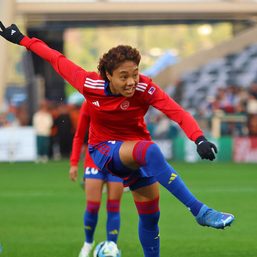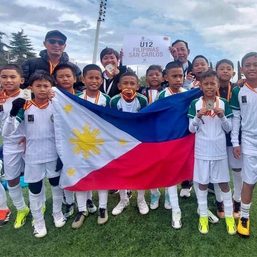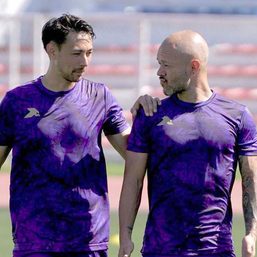SUMMARY
This is AI generated summarization, which may have errors. For context, always refer to the full article.
![[OPINION] The Women’s World Cup and understanding Filipino-America](https://www.rappler.com/tachyon/2023/08/Understanding-Filipino-America-and-their-place-in-Philippine-history-1.jpg)
In the Philippines’ first appearance on the Women’s Football World Cup stage, AP News reports, “Women’s World Cup team from Philippines has American flavor.” Filipino social media disliked the idea of what they call “American credit-grabbing” of the Western media. Five days later, Sarina Bolden scored a historic goal against New Zealand, giving the Philippines its first-ever win in the World Cup. The New York Times tweeted, “…Sarina Bolden, a California-born forward, scored the first goal in the Philippines’ World Cup history,” which caused another uproar on social media for our kababayans here in the country.
In 2020, however, I remember the discourse on social media about the use of Filipinx and how Filipinos here in the Philippines questioned the Filipino diaspora, particularly Filipino-Americans, about their “Filipino-ness.” As a scholar of nationalism caught in the crossfire, this made me think about where this is coming from; also to know the Filipino’s understanding of diaspora.
When I was studying for my undergraduate degree in history, there was no dedicated subject on the history of the Filipino diaspora and its intricacies. Neither was it tackled during our general education Philippine history.
Based on CHED Memorandum Order No. 38 (2017) concerning policies and guidelines for History program degrees in the country, there is no course devoted to studying the history of Filipino diaspora and migration. While thematic courses like Philippine Social History can tackle this topic in passing, it takes a course facilitator with a considerable understanding of diaspora studies to discuss it in toto.
The first question is: where do we start? In my search for answers, if we look for the beginnings of “Filipino diaspora,” we should begin with the American colonial period following the aftermath of the Philippine-American War. Historically, it was only during the long Philippine Revolution (1872-1902) that Rizal and the ilustrados cemented the idea of Filipino identity and that Aguinaldo and his revolutionary government established the concept of a Filipino nation when they asserted independence in 1898. The first Republic, however, was short-lived when the Americans took over. But the idea of Filipino as a national identity endured.
The Americans however saw this identity, which the revolution constructed for racial affinity and unity, as functional to colonialism. This “identity” was convenient for the colonizers to identify and segregate us from their newly acquired colonies racially: Puerto Ricans, Cubans, Guamanians, and Filipinos.
But many Filipinos saw this bane as an opportunity to better their lives, as the emerging American Empire required hired hands. However, it was not easy for them. According to my father, my grandfather has a personal history of diaspora. My grandfather together with his barrio relatives were part of the cohort of Ilocanos who was displaced to work in the plantations in Hawaii back in the 1920-30s. However, the hardship of labor across the Pacific was not for everyone. Like many Filipinos, homesick and skeptical during that period, my grandfather decided to return to the Philippines. While others chose to stay, bowing to the inevitable.
It is a fact, therefore, that Filipinos are significant in building America’s empire from the ground up.
The history of the Filipino diaspora is not limited to the American period. Regrettably, even after the Americans granted independence in 1946, the political and economic problems in the Philippines have continued to displace the Filipino. Some countries cite wars and conflict as the leading cause of diaspora, but in our country, the failure of the motherland remains the main culprit.
Filipinos here in the Philippines cannot simply accuse Filipino-Americans of wanting better when all of us here aspire to the same thing; to the point of even gambling our political and economic future by reinstating the son of a dictator.
While most of those who stayed and continue to relocate are already American by citizenship, they are still Filipino who trace their history and culture to inang-bayan (note: Filipino is not a race, but a modern invention or imagination in response to colonialism). Most of these generations of Filipino-Americans even did not wish to be born stateside. They were victims too of all the misfortune we experienced here in the country since the colonial and postcolonial times. What we face in the country is just as worse as what they face with the rising tide of white supremacy. We are all victims of history.
Surprisingly, a band of young Filipino/a/x scholars based in the US has given us the luxury to understand some unfamiliar historical segments in our past through their works. Not writing about diaspora or migration in particular, but these are, in my opinion, important works on how to see another layer of Philippine history unfolding from the lens of Filipino America and the scholars it continues to produce.
My introduction to these scholars and their works was Allan E. Lumba’s first book, Monetary Authorities: Capitalism and Decolonization in the American Colonial Philippines. Thanks to US-based Filipino historian Vicente L. Rafael’s promotion of Lumba’s book on Twitter and other Filipino/a/x scholars writing about the Philippines.
This year, we are blessed with the publications of Sony Corañez Bolton’s Crip Colony: Mestizaje, US Imperialism, and the Queer Politics of Disability in the Philippines; Genevieve Clutario’s Beauty Regimes: A History of Power and Modern Empire in the Philippines, 1898-1941; Adrian De Leon’s Bundok: A Hinterland History of Filipino America; Josen Masangkay Diaz’s Postcolonial Configurations: Dictatorship, the Racial Cold War, and Filipino America; and Tessa Ong Winkelmann’s Dangerous Intercourse: Gender and Interracial Relations in the American Colonial Philippines, 1898-1946. And I believe there are more that have not reached my radar.
These are new materials that we can use during Philippine history classes; better, a call to Filipino teachers here in the Philippines to add Filipino-America in understanding the Filipino nation not only as geographical but more of a perception of identity that extends to diasporic settlements beyond the seas. But I hope that these titles will also have their local editions be more accessible.
With the growth of Filipino-American scholarship, we can argue that the history of Filipino-Americans, or the diaspora in particular, is also the history of the Philippines, in general. There is no divide between identity and experience whatsoever. And I can only see that the Pacific Ocean is what separates us and the kababayans stateside.
Filipinos here in inang-bayan just need a historical understanding of Filipino migration and diaspora so that we become closer to them. And that we can put an end to social media debates about “Filipino-ness.” – Rappler.com
Luis Zuriel P. Domingo teaches history at the University of the Philippines Baguio. His research interests include the history of nationalism in Southeast Asia and beyond. He is also on Twitter @domingozuriel.
Add a comment
How does this make you feel?





There are no comments yet. Add your comment to start the conversation.